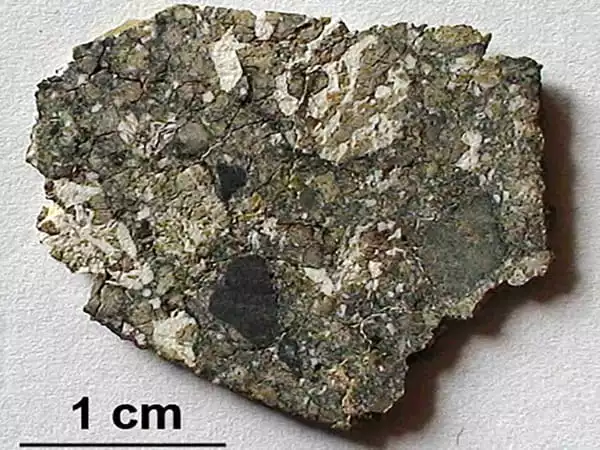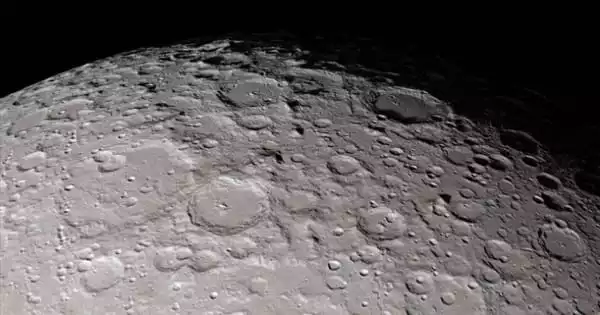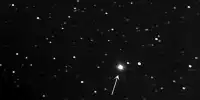A lunar meteorite is a meteorite that has been identified as having originated on the Moon. A meteorite colliding with the Moon is typically classified as a transient lunar phenomenon. The high-pressure mineral Donwilhelmsite, which was recently discovered in the lunar meteorite Oued Awlitis 001 from the Apollo missions, is crucial for understanding Earth’s inner structure.
Donwilhelmsite [CaAl4Si2O11] was discovered by a team of European researchers in the lunar meteorite Oued Awlitis 001. The findings were published in the scientific journal American Mineralogist by a team led by Jörg Fritz of the Zentrum für Rieskrater und Impaktforschung Nördlingen, Germany, and colleagues from the German Research Centre for Geoscience GFZ in Potsdam, Museum für Naturkunde Berlin, Natural History Museum Vienna, Institute of Physics of the Czech Academy of Science, Natural History Museum Oslo, University of Manchester, and Deutsches Zentrum für Luft und Raumfahrt Berlin.
Aside from the 382 kilograms of rocks and soils collected by the Apollo and Luna missions, lunar meteorites provide valuable insights into the Moon’s formation. They are ejected onto the lunar surface by impacts and then delivered to Earth.
Donwilhelmsite is the first high-pressure mineral discovered in meteorites, and it has applications in subducted terrestrial sediments. It is primarily made up of atoms of calcium, aluminum, silicon, and oxygen.
Jörg Fritz
Some of these meteorites were subjected to extremely high temperatures and pressures. Extreme physical conditions frequently resulted in shock melting of microscopic areas within these meteorites. These shocking areas are extremely important because they reflect pressure and temperature regimes similar to those found in the Earth’s mantle.
As a result, the microscopic shock melt areas are natural crucibles that host minerals that would otherwise be inaccessible at the Earth’s surface. Minerals such as wadsleyite, ringwoodite, and bridgmanite make up a large portion of the Earth’s mantle. High-pressure laboratory experiments were used to create these crystals. They were first described and named as natural minerals based on their occurrences in meteorites.
Donwilhelmsite is the first high-pressure mineral discovered in meteorites, and it has applications in subducted terrestrial sediments. It is primarily made up of atoms of calcium, aluminum, silicon, and oxygen. Donwilhelmsite was discovered in the shock melt zones of the lunar meteorite Oued Awlitis 001, which was discovered in Western Sahara in 2014. This meteorite has a similar composition to the rocks that make up the Earth’s continents. Wind and rivers transport eroded sediments from these continents to the oceans, where they are subducted into the Earth’s mantle as part of the dense oceanic crust.

As the minerals are dragged deeper into the Earth’s mantle, pressure, and temperature rise, and they transform into denser mineral phases. Donwilhelmsite, a newly discovered mineral, forms at depths ranging from 460 to 700 kilometers. Donwilhelmsite is thus an important agent in the terrestrial rock cycle for transporting crustal sediments through the transition zone separating the upper and lower Earth’s mantle.
This pan-European collaboration was critical in obtaining the lunar meteorite, recognizing the new mineral, understanding its scientific significance, and accurately determining the crystal structure of the tiny, thousands of parts of a millimeter thick, mineral crystal. “At the GFZ, we investigated microstructural aspects of the samples using transmission electron microscopy,” says Richard Wirth from the section “Interface Geochemistry.” “Our findings, as well as the crystal structure analyses of our Czech colleagues, highlight the importance of transmission electron microscopy in the geosciences.”
One in every thousand newly discovered meteorites is a lunar meteorite, while the vast majorities are asteroid belt meteorites. In the early nineteenth century, most scientists believed that all meteorites that fell to Earth came from the Moon. Although only a minority of researchers believe it, there are theories that tektites are from the Moon and should thus be classified as lunar meteorites. However, most scientists believe that such theories are out of date.
The new mineral was named after lunar geologist Don E. Wilhelms, an American scientist who was involved in the Apollo space missions’ landing site selection and data analysis, which brought the first rock samples from the Moon to Earth. The Natural History Museum Vienna has on display a portion of the meteorite Oued Awlitis 001, which was acquired through the crowdfunding campaign “Help us to get the Moon!”














